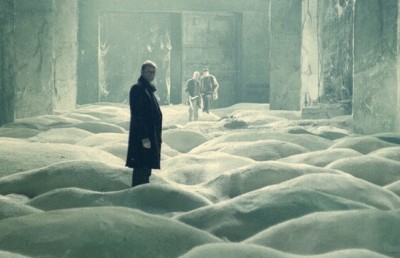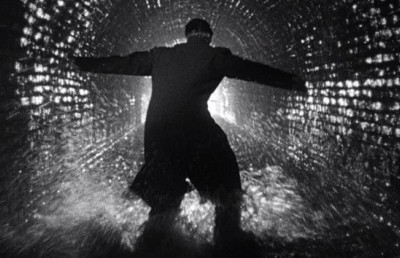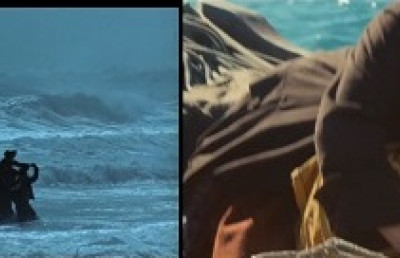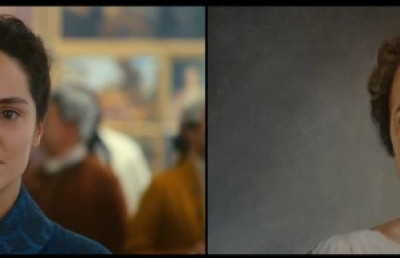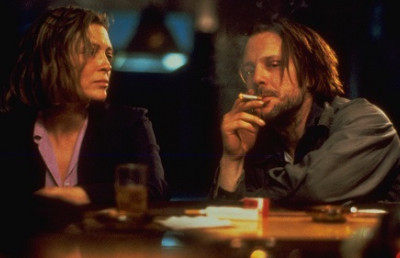The Wild, Wild World of Diabolik & Co: Adults-only comic books on screen in the 1960s
Fumetti Neri
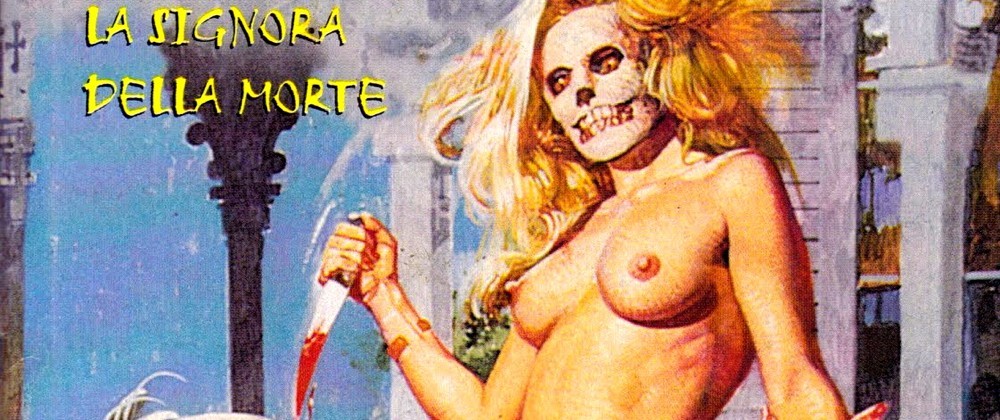
Nineteen Sixty-Two. After the difficult post-WW2 years, Italy had finally recovered from a tremendous economic letdown. Those were the years of the so-called boom. The indigenous movie industry was so healthy and vital that Cinecittà was being referred to as ‘the Hollywood on the river Tevere’. Fellini, Antonioni, De Laurentiis. LA DOLCE VITA. Being an adolescent in 1962 meant riding a Vespa, listening to pop singer Adriano Celentano, dreaming of Sophia Loren and Anita Ekberg. Morals were slightly changing, loosening. It was the perfect moment for a new trend in popular culture: the so-called fumetti neri (literally, ‘black’ comic books, so called because of their sordid content). Comics were already immensely popular, especially among lower classes, but when Angela and Luciana Giussani launched Diabolik, it was suddenly obvious that something was going to happen. This small, pocket-sized comic strip, although labelled ‘for adults only’, was clearly aimed at a teenage, hormonally raging audience. But if Stan Lee’s superheroes were good guys fighting against evil, Diabolik was plain mean. He was a cat burglar, but, indeed, not an ordinary one. His costume was evocative and trendy, his gadgets rivalled Batman’s (or, more coherently, James Bond’s), his brilliance in disguise was phenomenal, and – most of all – he had two very clearly expressed goals: money and sex. Yes, Diabolik did it -with a gorgeous blonde named Eva Kant. The arch criminal’s overt sexual life frustrated even the poor inspector Ginko, always in pursuit of the criminal mastermind in black leotards.
Forty years later, it’s easy to dismiss Diabolik (the comic book is still published today, though, and still retains large popularity) as a bland, none-too-exciting and stylistically less than notable creation. But its pioneering importance is fundamental. Soon the market was flooded with cheap fumetti (120 pages pocket-sized, with two panels on each) whose main characters had to have a K in their nickname. The most important and influential of all was, undoubtedly, Kriminal. Magnus & Bunker (real names Roberto Raviola and Luciano Secchi) were a pair of young and enthusiastic movie-goers who immediately understood the potentialities of the Diabolik concept, and the improvements they could add to it. Bunker, the writer, came up with grand pulp ideas which Magnus, an original, innovative artist with a peculiar, almost self-parodic style, managed to expand and visualize. Kriminal’s skull-masked trademark costume, for example, is a stunning pop-art creation, something you can never forget once you’ve seen it.
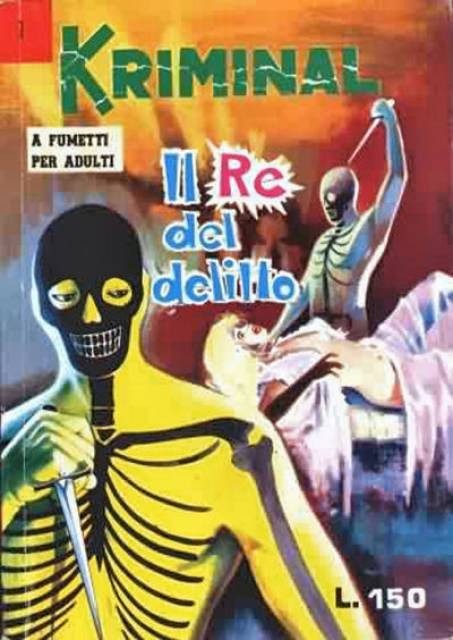
Kriminal was ultimately more successful than Diabolik, at least on a creative basis because Magnus & Bunker understood that they had to bring out the sexual and violent elements as far as possible, so as to create the definitive, immoral anti-hero. If Diabolik is just a thief after all, Anthony Logan aka Kriminal is a bloody son of a bitch, a cold-blooded murderer who kills people in industrial quantities just as if it was the most natural thing in the world. Diabolik is rigidly monogamist, whereas Kriminal is promiscuous in the extreme. He seduces scantily dressed, provocative women and then indifferently strangles or stabs them to save his identity. No remorse, no regrets. He’s really evil, and an anarchist to boot. Traditional values are joyously destroyed by Magnus & Bunker’s iconoclast approach, and the duo always keep their tongues firmly planted in their cheeks. Moreover, their stories are very reminiscent of contemporary B-movies, so much so that Kriminal #3, “Omicidio al riformatorio” (dec.1964), almost looks like a novelization of Bava’s BLOOD AND BLACK LACE (SEI DONNE PER L’ASSASSINO) set in a reform-school! The subterranean umbilical cord between fumetti neri and genre cinema is even stronger in M&B’s follow-up, Satanik. The horrific angle is the perfect counterpart for erotic frissons in the adventures of Marny Bannister, an even more unscrupulous incarnation of duchess Du Grand (I VAMPIRI/THE DEVIL’S COMMANDMENT), continuously mutating from old hag to ravishing red-haired slut thanks to a mysterious rejuvenating potion. Satanik predates Italian sex-horror of the seventies, when the loosening of censorship would allow Rosalba Neri to bathe in blood in THE DEVIL’S WEDDING NIGHT (IL PLENILUNIO DELLE VERGINI, 1973) and Rita Calderoni to walk around in the nude in the aptly titled NUDE FOR SATAN (NUDA PER SATANA, 1974), both directed by Paolo Solvay [Luigi Batzella]. Although relatively tame (there was scarcely a bare breast, but the eroticism that came from Magnus’ deliciously long-legged women in suspenders and bra is still irresistible), Kriminal and Satanik were a punch in the stomach of respectability as well as a loud, lewd jeer to the superficial society they were spawned by. The omnivorous (and decidedly prolific) duo even approached the spy genre (Dennis Cobb) and space operas (Gesebel): even if these met a decidedly less exciting commercial response, they are noteworthy as they play with genres the way the juiciest B-movies did: Cobb recalls the sauciest spaghetti Bond imitations, whereas Gesebel features Margheriti’s Gamma One spaceships as well as interstellar busty amazons!
It took a bit before producers eventually decided to transpose ‘fumetti neri’ on screen, and the reason is obvious once you watch the films – or, at least, the vast majority of them. Many comic-strip adaptations for the big screen suffer from a self-restrained approach, undoubtedly conditioned by the negative reactions of the so-called ‘moral majority’ against the ‘fumetti neri’ and their supposed influence over a young and gullible audience (De Laurentiis even forced Bava to tone down the excessive violence in DIABOLIK); unfortunately this ultimately bogged the films down: besides their unfaithfulness to comic-books and their spirit, the filmmakers’ style and inventiveness got severely diminished, leading to moderately pleasant but anonymous adventure flicks which lacked the zero-budget craziness of so many Italian James Bond rip-offs. However, the very first masked anti-hero to benefit from a theatrical run was neither Diabolik nor Kriminal, but one of the most squalid and forgettable paperback rip-offs, Sadik. For once, parody preceded the real thing: the episode SADIK is actually part of an omnibus black comedy, THRILLING (1965, directed by Gian Luigi Polidoro, Ettore Scola and Carlo Lizzani), which satirized the growing success of horror movies, mixing these themes with the traditional ‘commedia all’italiana’ motifs. Walter Chiari stars as Renato Bertazzi, a stressed businessman who not only has to conclude a difficult deal which may be decisive for his career, but must also cope with his sex-obsessed, comics-addicted wife Valeria (Dorian Gray) and her bizarre erotic fantasies. She asks Renato to dress up as ‘Sadik’ and pretend to rape her just like in an adults-only fumetto nero. Although working on what’s ultimately little more than an extended sketch, director Polidoro makes the best use of stylised b&w lighting and weird camera angles to suggest the visuals of a comic strip, even using balloons instead of dialogue, and in the meantime ridiculing the hypocritical mentality of the emerging middle classes. After many hilarious incidents (he is forced to burst into the apartment through a window in order to spice up the masquerading, and so on) poor Bertazzi finally succumbs to the fictional character he is playing and stabs the woman when he finds out she’s rejected an important phone call because she didn’t want to be disturbed.
Then Umberto Lenzi’s KRIMINAL came out in 1966. Blonde-haired, handsome Anthony Logan was played by Glenn Saxson, whose screen debut, Roberto Infascelli’s LUANA LA VERGINE DELLA GIUNGLA (1958), a tepid exotic jungle adventure, hadn’t lead him on to bigger things. Lenzi opted for a lighter tone in jarring contrast with the comic strip’s explosive mixture of sex and violence. ‘I saw it recently on TV and it seemed even better than when I shot it in 1966: then I was a bit perplexed, now I appreciate the aspect of irony in it, something which comic strips didn’t have, because they were vulgar, horrible,’ he says. 1 Lenzi claims he argued with Bunker about some major changes he made to the author’s character ‘because it was a bit Nazi-skin fascist (sic!). We made a fun film.’ It is unlikely that Lenzi ever took more than one or two distracted glances at the comic strip, otherwise he would have noticed its firm tongue-in-cheek attitude. Anyway, if the movie is none too convincing, that’s just because of this ‘fun’ attitude. The comic-strip style opening titles are very promising, anyway, epitomizing the whole plot through a series of panels depicting Kriminal at work, while a driving, easy-listening score provides us with an instantly memorable guitar riff. 2 The costume has been redesigned due to practical (and budgetary?) reasons, though, and looks rather impoverished, with the trademark skull mask replaced by a cheapo-looking hood. Perhaps that’s why Saxson acts most of the film without the skeleton costume on. The film chronicles Kriminal’s last-minute escape from execution and his tribulations on the track of a bunch of stolen diamonds, which lead him face to face with such lovely ladies as Helga Liné and Mary (BLOOD AND BLACK LACE) Arden. Despite Lenzi’s claim that ‘we used the style of the comic strip in the film’, there is actually little of it in the movie, which looks more like one of those travelogue James Bond rip-offs that were flooding the screens in that period. Saxson moves from London to Spain and then to Istanbul like a Sixties’ version of Arséne Lupin, seemingly more concerned with his peculiar disguises than with anything else, and despite a profusion of fashionable decollétees and hairdos his sexual adventures are very mild and chaste; same regarding violence, except for a suitably nasty moment when Kriminal takes his revenge on scumbag Ivano Staccioli by secretly replacing his shaving foam with vitriol… Although the film benefits from fast pacing and judiciable direction, its indifferent, undistinguished plot ultimately bogs it down, depriving the film of any interest whatsoever: Saxson could well be anybody else instead of Kriminal and that wouldn’t change things a bit. All things considered, KRIMINAL is fast, fun and overall very entertaining but disappointingly tame when compared to its source of inspiration.
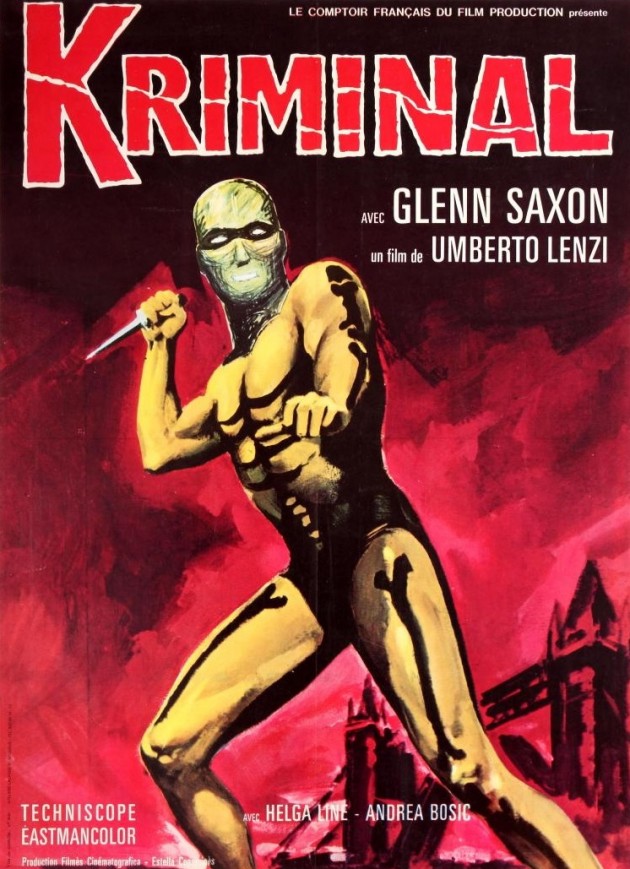
The sequel, IL MARCHIO DI KRIMINAL was directed by veteran Fernando Cerchio, director of many sword and sandal epics as well as several tongue-in-cheek parodies (TOTÒ CONTRO IL PIRATA NERO, starring famous Neapolitan comedian Totò). Our hero is now the director of a home for the old, and together with his mistress (who lovingly nicknames him ‘My little skeleton’) dons his costume and mask to provoke fatal heart attacks among the guests and then get the insurance money. The casual discovery of a map hidden inside a Buddha statuette leads to a treasure hunt for some lost Goya and Rembrandt paintings. Once again, Andrea Bosic plays Kriminal’s nemesis inspector Milton, while Helga Linè makes a welcome appearance (no connection with the character she played in the first one, though) in her favourite femme fatale role. Despite a disappointing second half, which again turns into a banal travelogue adventure film, IL MARCHIO DI KRIMINAL is perhaps more interesting than its predecessor: Cerchio makes a pointed use of comic book panels and the strip’s flair for offbeat, grotesque supporting characters is rendered rather successfully; what’s more, the beginning, with Kriminal frightening a poor old lady to death in her bed, is positively irreverent and sets the tone for a more humorous, nastier plot, where at least Anthony Logan’s alter-ego has the chance to show up a bit more often. The ending panel looks like a locandina for HELLZAPOPPIN’, with devils in hell, armed with forks and ready to greet him. R.I.P., Tony.
In 1967, the much-awaited DIABOLIK finally hit the screens. Producer Dino De Laurentiis had chosen Mario Bava to direct the film not just because of the director’s solid fame as a master of fantastic cinema, but to save money as well, thanks to Bava’s ability of doing wonders with very little, as amply demonstrated by his earlier works, particularly TERRORE NELLO SPAZIO (1965). Consequently, the budget was far from huge (about 200 million liras), while ‘name’ actors like Adolfo Celi (fresh from THUNDERBALL) and Michel Piccoli were cast in small roles – the former as jinxed villain Valmont, the latter as Inspector Ginko. The masked anti-hero had the unexpressive features of John Philip Law while Eva Kant was played by the late Marisa Mell. 3 Despite its budgetary limits and an episodic screenplay, DIABOLIK is – together with Kinji Fukasaku’s delightful KUROKOTAGE (BLACK LIZARD, 1968) – THE pop-art movie of the decade. Bava does not demystify his protagonist by pressing the pedal of irony, nor does he try for a ‘knowing’ approach. Everything is strictly one-dimensional, a series of coloured, shiny surfaces and moving objects that fill the screen with no inner logic except their being designed for the viewer’s pleasure. 4 This way, Law’s Diabolik, with his permanent cynical grin, feline movements and limited facial expressions, is a perfect counterpart to Bava’s style, being himself just an object among other objects in a world apparently devoid of ‘normal’ people and literally painted on the screen in gorgeous primary colours. Diabolik and Eva, so physically similar they almost look like siblings, exude an overt sensuality that bursts out of almost every sequence: Bava is more interested in filming his protagonists while they are showering, making love or caressing each other, with the accompaniment of a sensual female voice in Morricone’s score, rather than in their criminal exploits. Their perfect bodies must be continually explored yet left untouched, as in the chilling autopsy scene, with Law in a state of apparent death and about to be sliced open by the coroner. Here the director shows his skill as a master of suspense by arranging Diabolik’s ‘resurrection’ at the very last second. The hero’s carnality is sublimely rendered in the ending, when he is covered from head to toe with molten gold, thus becoming a living statue, a perfect monument to himself. (Bava would have probably laughed when asked about this, but the image of Eva Kant kneeled before her lover, silently crying and caressing his new shining skin, seems like a tribute to a similar moment in Bunuel’s L’AGE D’OR). If Diabolik is a master of disguise, Bava proves once again that he is the Grand Master of illusion, creating the hero’s hidden cave with the help of a handful of props, some paper-retailed models and a few mirrors. Therefore, DIABOLIK is a ‘popular’ film in the purest sense of the term, because not only does it come from popular culture, but it is made with a popular attitude and even uses cheap, popular material. In this latter sense it succeeds where Joseph Losey’s MODESTY BLAISE failed: rendering a convincing, sincere portrait of its time.
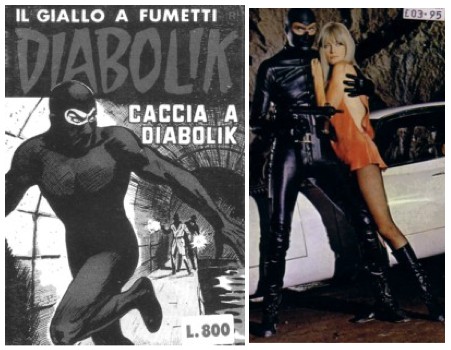
Fumetti to the screen
It was inevitable, and soon afterwards came the wall-to-wall spoof, ARRIVA DORELLIK (1968) directed by Steno (Stefano Vanzina) and starring singer/tv host turned actor Johhny Dorelli. The film, however, makes reference to Dorelli’s tv character of Dorellik, an idiotic Diabolik look-alike characterized by an asinine laughter and a selection of gadgetry borrowed directly from BATMAN-THE MOVIE (1966). DORELLIK is an amiable, amusing farce which unpretentiously ties a number of Dorelli’s tv sketches together: the plot, a sort of extension and expansion of Robert Hamer’s classic KIND HEARTS AND CORONETS (1948), has our hero offing one by one all 400 members of the Dupont family so that he, being the only heir left, will receive an enormous inheritance. Gap-toothed Terry-Thomas plays the dumb inspector, while lovely Margaret Lee is Dorellik’s lover. The ending, with the two antagonists deliriously switching their identities while unmasking each other, was to be found more than twenty years later in Ezio Greggio’s IL SILENZIO DEI PROSCIUTTI/SILENCE OF THE HAMS (1991).
Eclectic director/songwriter Piero Vivarelli poked his nose twice into the genre, with decidedly forgettable results. MISTER X (1966), directed under the pseudonym ‘Donald Murray’, deals with a modern Arséne Lupin, master of disguise and golf champ in his spare time (‘I won the last eight editions of the world Championship’ he claims) who is framed by a drug kingpin for the murder of his mistress, who had discovered a little too much about her lover’s traffickings. Mister X follows the bad guys to Capri and proceeds to turn the tables on them, destroying their international drug ring. Although the credits show a titillating series of suitably lurid panels, the films turns out to be a lackluster, half-baked potboiler with almost no references to the comic book world it comes from. The problem is that Mister X is an uninvolving, unsympathetic hero, who lacks the edgy working-class appeal of his contemporaries: his jet-set attitude, good table manners and general stiff upper-lipped demeanor are a far cry from Kriminal’s genuine low class nastiness, so much so that he looks visibly less uncomfortable wearing a tuxedo than his anonymous trademark black hood ‘n’ leotard. Even if the Interpol is after him, Mister X is just a good guy after all, and this makes him such a bore. The most notable thing, besides the presence of future Fernando Di Leo regular Pier Paolo Cappon 5 —billed as Norman Clark— as the mysterious Mister X, is the use of sets previously seen, among other films, in Bava’s SEI DONNE PER L’ASSASSINO. 6
SATANIK (1968), although incongruously set in Spain for coproduction reasons, is the only one among these films not to start in the middle of action but focusing on the birth of its evil heroine. For the first 15 to 20 minutes the picture closely follows the footsteps of Magnus & Bunker’s first episode, depicting Marny (sic) Bannister’s transformation into the gorgeous Satanik (although this name is curiously never mentioned during the film). Despite Magda Konopka’s greenish-looking, awfully bogus ‘old hag’ make-up (so carelessly conceived one wonders whether anybody was taking the whole thing seriously), there is still enough material for the viewer to hope for a more promising development; however, things just get worse and worse, as Vivarelli abandons the fantastic territory for a depressingly banal story involving a diamond necklace (again!), the heroine’s dispatching of a horny jeweler (Umberto Raho, billed as Humi Raho), and her teaming with a gang of crooks in Geneve. Yawn… (In the strip Satanik had to face monsters and even a vampire named Wurdalak, after Bava’s episode in I TRE VOLTI DELLA PAURA.)
Breathtakingly curvaceous Magda Konopka – whose blink-and-you’ll-miss-it topless scene is perhaps the sole point of interest of Fenando Cerchio’s lame spy-flick SEGRETISSIMO, made one year earlier – is perfect as the evil, sexy murderess, but sadly director Piero Vivarelli leaves her with nothing to do except bitching around in sexy outfits, performing a strip-tease and an enticing night-club act (which IS worth seeing), while donning a Diabolik-style mask and eventually falling down a cliff with her car in one of the most anticlimactic endings ever committed to screen. SATANIK is ultimately tame and mild to the point of self-sabotage, a film that is so afraid of its own potential anarchic content that it proceeds to deny it meticulously as it goes along, undermining every spark, every idea, every single interesting moment with an indifferent, routine approach that is jarringly inept and useless. Perhaps this aberration gave young assistant director Pupi Avati a good lesson on how NOT to make a fantastic film. 7 Luckily for us viewers, he was an apt pupil.
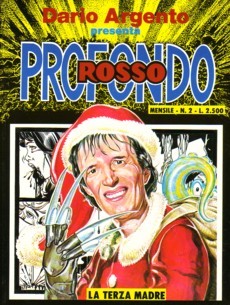
Argento’s fumetti-styled horror comics
Times were changing, and the fumetti neri boom was soon over; most of them disappeared as quickly as they had popped up. Magnus and Bunker kept publishing Satanik and Kriminal until the early Seventies, but their biggest hit was to be the spy spoof Alan Ford, issued in July 1969, which became (and still is) sort of a cult phenomenon among devotees. Meanwhile, another powerful trend was taking over, that of erotic pocket comics (many were actually sexy/horror hybrids, such as Jacula and Zora la vampira), which would soon evolve into hardcore pornography by the mid Seventies. 8 Inevitably, producers would grab their boards and swim to the next big wave, faithful as always to exploitation’s ever-favourite strategy – the surfing principle.
Notes
- Eating Lenzi —Umberto Lenzi interviewed by Andrea Giorgi in Necronomicon #5, 1994. ↩
- Comic-strip panels reappear for the ending, when Kriminal is finally caught, but this seems less a homage than an expedient way to save time and money. ↩
- Production manager Bruno Todini is particularly sharp-tongued towards Law and Mell, even referring to the former as a ‘general land office employee’. It must be added that De Laurentiis’ first choice as Eva (to whom Bava sternly opposed) was Catherine Deneuve. Mell’s career knew a terrible breakdown by the end of the seventies, due to the actress’ drug addiction: in the mid-eighties she even appeared in a number of hardcore photo sessions published on the adults-only magazine ‘Le Ore’, although not performing sexual acts herself (other down-to-their-luck actresses who had to face such a humiliation were Tina Aumont, Lilli Carati, Paola Senatore and Karin Schubert). Mell died of throat cancer in 1992, at the age of 53. ↩
- Future director Flavio Mogherini (LA RAGAZZA DAL PIGIAMA GIALLO/THE PYJAMA GIRL CASE) provided the sets -of course, with a great deal of help from Bava himself. ↩
- Capponi starred as Duca Lamberti in I RAGAZZI DEL MASSACRO/NAKED VIOLENCE (1968) and then played Cocchi in IL BOSS (1973); he and Di Leo teamed again on DIAMANTI SPORCHI DI SANGUE/BLOOD AND DIAMONDS (1978). ↩
- The party scene in MISTER X takes place in the very same set used for Lea Kruegher’s murder in SEI DONNE PER L’ASSASSINO (Franco Ressel’s villa in the film). ↩
- “Watching how he used to direct, after just four weeks I thought:‘Then I can be a director myself!’ and when the crew moved to Spain I told them: ‘No way, I’m gonna stay here in Bologna and shoot my own film [Balsamus, NdA]”, Pupi Avati, in F.Faldini, G.Fofi, L’avventurosa storia del cinema italiano… 1960-1969, Feltrinelli, p.206. ↩
- Having parted ways with Bunker in 1975, Magnus created a number of stylish, exceptionally cured comic books that caused a sensation among fumetti fans: Lo Sconosciuto (1976) a hard-boiled, ultra-violent saga about a nihilistic mercenary, was the very first comic book to show hardcore images, while Necron (1978) mixed wall-to-wall hardcore, outrageous humour and splatter in a way that was both exhilarating and graphically innovative. Magnus died in February 1996, soon after completing La valle del terrore, a mammoth, epic coffee table book dedicated to western hero Tex (a comic brought to the screen in 1985 by Duccio Tessari with TEX E IL SIGNORE DEGLI ABISSI, starring Giuliano Gemma and William Berger). ↩




